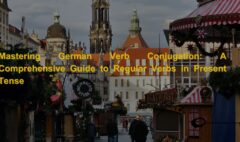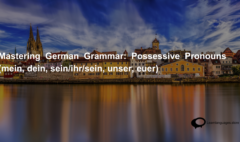The Common European Framework of Reference for Languages
The Common European Framework of Reference for Languages
Points on the Common European Framework of Reference for Languages. Do you have plans to study a new language, maybe one spoken in Europe? If so, you’ve probably heard of DELE A1, CELI B2, and DALF C1 among other language proficiency exams.
Estimated reading time: 13 minutes
Do you know that the Common European Framework of Reference for Languages (CEFR) serves as the basis for almost all European standardized tests? Exactly what are they? Is this worldwide system significant, and which languages use a CEFRL-style notation? Would there be any drawbacks to this? Let’s read this article and learn all we can. And the best way to do so is to take one of the well-recognized language tests.
When you pass one of these exams, you’ll be given a grade and promoted to the next level. For instance, HSK level 5 in Mandarin Chinese, CAPLE in Portuguese, SIELE in Spanish, CILS in Italy, and JLPT N2 in Japan. If you aren’t a native speaker, you may find out how well you can communicate by taking one of these exams. As a result, this has an indirect bearing on competence, productivity, and efficiency.
As a result, you can gauge their level of linguistic proficiency more accurately. Therefore, to achieve your goals and thrive in a variety of professional contexts. However, the amount of difficulty, types of questions asked, and overall organisation of these exams varies widely. That’s because each one adheres to its own set of rules, principles, and structures. When compared to other language models and standards, the Common European Framework of Reference for Languages (CEFR) has the widest acceptance and use. It is followed by more than a dozen well-known exams.
Let’s skip this and go to the next section.
The CEFR levels are:

Variously abbreviated as CEFR, CEF, and CEFRL, CEFR refers to the Common European Framework of Reference for Languages. The Council of Europe developed this standard and is actively promoting its implementation.
The Common European Framework of Reference for Languages (CEFR) is a global benchmark for evaluating language proficiency. It’s a helpful tool for gauging one’s level of linguistic competence and making meaningful comparisons between speakers of different languages. Each of the four modalities (oral, written, read/listen) is represented in full detail. Candidates’ general language skills are evaluated, as opposed to particular ones like reading comprehension or listening comprehension.
Using the CEFR as a starting point, educators may create consistent language curricula. Textbooks, tests, curricular rules, etc., are included on a global scale. For European languages, this is the de facto standard for evaluation purposes.
If you’re learning French, you may wish to take the DELF, DALF, TEF, or TCF Canada exams. The Common European Framework of Reference (CEFR) serves as the foundation for all of these French language assessments. So, it’s a useful tool for determining which academic challenge is best for you.
Use it in what way?

Exams based on the Common European Framework of Reference for Languages (CEFR) are comprehensive in their assessment of language proficiency. All four of the aforementioned abilities are required. It encompasses many important facets, not just linguistic skills. Things like the ability to translate and comprehend texts, as well as a grasp of literature, history, culture, and specialised knowledge.
If you need a credible and official certificate to demonstrate your present level of language proficiency for purposes of further education or employment, we can assist. After that, you may administer one of the examinations based on the Common European Framework of Reference for Languages.
Fortunately, there are free and accessible alternatives to traditional methods that can be found on the internet. However, the majority are subpar and fail to do justice to your linguistic prowess. Furthermore, few institutions value or even recognize such credentials.
Therefore, while it may cost some money, it is preferable to take an official exam acknowledged by the relevant authorities. You get to choose the language and the difficulty level to suit your needs. Take the Test of English as a Foreign Language (TEF) Canada, for instance, to boost your chances of obtaining permanent residency in Canada. And strive for CLB7, which requires at the very least B2 and preferably C1.
Aim for B2 on either the Goethe-Zertifikat or TestDaF if you want a career that requires German. There are point systems for certain tests including the TEF, TCF, and SIELE. The tests cover the gamut from elementary school level (A1) to college level (C1) in all four disciplines. This implies that you will not be able to choose a language proficiency level on the form, such as DELF A2 or DELE B2. Take a test instead, such as the TCF Quebec or SIELE Global, to find out where you stand.
That’s why you may earn a score of B1 in oral communication, A2 in written communication, and C1 in reading. That said, knowing your level of and areas of expertise is facilitated by this. So, you may zero in on the areas that need improvement, take only one exam, get your true score and receive your certified certification.
The Value of CEFR Levels and What They Mean

Language examinations based on the Common European Framework of Reference for Languages (CEFR) provide various benefits. First, there are a number of academic contexts in which certificates and diplomas that align with CERF levels might be useful. For instance, you may need to pay for the costs associated with continuing your education after high school or college.
Educators and schools benefit from this as well. They tailor the material they provide to each individual class’s needs. Additionally, CEFR levels are universally transferable across languages it supports. A student who studies Italian in Spain and achieves Level B1 is linguistically equivalent to a student who studies Portuguese in Germany at the same level.
Indefinite validity of CEFR certification. If you’re interested in a career in languages or require language abilities for your current employment, the Common European Framework of Reference for Languages (CEFR) certification is invaluable. In addition, CEFR is often used by employers as a means of evaluating a candidate’s linguistic competence and performance on language-related tasks.
If you’ve been studying a foreign language for a time, you probably want to know how far along you are. Moreover, there are several reasons why you would want to go to the next tier. Using the Common European Framework of Reference for Languages (CEFR), individuals may evaluate their own linguistic competence. It reveals your faults as well as your strengths. This should inspire you to work on your shortcomings and be ready for the future.
Those who are trying to learn will find this very inspiring. As you go from beginner to advanced speaker, from A1 to C2, you may take pride in your accomplishments. CEFR emphasises the importance of communication and practical language abilities. Not only that, but the cultural norms and traditions of the nations and languages at issue are also highlighted.
CEFR’s Drawbacks
There are some well-documented benefits, but there are also some drawbacks to consider. To begin with, there is a disparity between several exams that purport to measure linguistic competence. Worldwide, a broad variety of leveling methods are in use.

The reading, writing, speaking, and listening components of the CEFR-aligned language assessments are all evaluated. There are standardized language examinations out there, but some of them, like the TOPIK, HSK, and JLPT, leave out the speaking portion. Additionally, there is a wide range of CEFR-based difficulties.
Finally, it is important to note that there is no universally accepted standard for language tests. Second, the use of CEFR levels is limited to academic and professional contexts.
Travel and cultural interests are the primary motivators for most language students. And other people have very private motives for learning the language, such as sharing a passion with others or communicating with long-lost relatives. Reading, listening, speaking, and writing are not all necessary aspects of the Common European Framework of Reference (CEFR) to achieve these aims. You may get by with only the talking part.
Additionally, CEFR includes theoretical material that you may never need. To top it all off, you’ll need to put in a lot of time and effort studying, spend a fair sum to take the exam, and succeed in order to get the coveted certificate. You don’t require CEFR levels in any of these situations. Learning a language is a fun activity that may provide you pleasure and satisfaction.
Points on the Common European Framework of Reference for Languages
There are three levels within the CEFR, and they are Pre-B1, Pre-B2, and Pre-B3. There are a total of six layers, with two tiers inside each tier.
The Common European Framework of Reference (CEFR) describes the range of abilities that people have as they go from beginner to expert proficiency in a language. The skills that students should develop throughout the reading, listening, talking and writing are detailed at each grade level. According to the “A” Levels of the Common European Reference Framework (Basic User) Essentials are in the A-category. Additional categories include A1 (Breakthrough) and A2 (General) (Waystage).
A1 (Beginner)

The goals of a language course for a student at the CEFR Level A1 are for the student to be able to: Familiarity with simple language and its application to real-world problems. It’s OK to shake hands and introduce yourself and others. Location, friends, acquaintances, and goods are all fair game for inquisitive questioning.
Discuss everything from what you wore to what you ate to your daily routine, the weather, and even your health and wellbeing. Additionally, travel destinations, lodging, market purchases, interests, and recreational pursuits.
Conversational A1 is useful for talking to medical staff, front-desk personnel, and service staff. You may talk to a total stranger, debate with coworkers, and more all in one place.
If the other person speaks slowly and clearly, you should be able to understand each other.
Language learners starting at Level A1 (Beginners) have no background in the target language. The levels of some, such as pre-A1, A1.1, A1.2, etc., are further split in two.
A2 (Elementary) (Elementary)
A language student at the CEFR Level A2:
Capacity to grasp such topics as one’s own background and relationships, as well as shopping, local geography, and potential career paths. Expressed in a variety of ways (e.g., shopping, local geography, job).
Rapidly communicate basic information in the course of everyday, easy chores. Subject matter need not be out of the ordinary or commonplace.
Someone who, in a few sentences, can explain key features of their immediate surroundings. Also, pressing future concerns. It is possible to have a conversation about travel plans, shopping, and business. Past lives, medical aid, and other similar topics may also be discussed. Movies, weekend activities, and other forms of student enjoyment may be openly discussed in A2.
Discuss your recent travels, share some thrilling tales, etc. Those with some familiarity with the target language should aim for A2 (Elementary). Learners have a foundational grasp of spoken, written, and aural communication in authentic settings. Words at the B-Level of the CEFR Language Scale (Independent User) Users at the B level are self-sufficient. They are broken down into B1 (Threshold) and B2 (Below Threshold) bands (Vantage).
Broad “B” is sometimes further subdivided by many educational institutions into “B1.1,” “B1.2,” “B2.1,” “B2.2,” “B2.3,” etc.
B1 (Intermediate) (Intermediate)
Language learners at the B1 CEFR level:
Having a firm grasp of the fundamentals of well-articulated, standard input on issues one regularly encounters in one’s employment, studies, leisure, and other aspects of daily life.
When visiting a country where the language is widely spoken, you won’t have any trouble navigating most social or professional settings. Capable of composing well-organized, easy-to-understand pieces on one’s own turf.
It gives a concise summary of one’s thoughts and goals and summarises one’s experiences, aspirations, and objectives.
Negotiate effectively in your area of expertise. Conversations, both informal and official, may be held at a leisurely pace
B2 (Upper Intermediate) (Upper Intermediate)
A student of the language at the B2 CEFR level:
Possessing the literacy to read and understand complicated literature on both tangible and abstract matters within their area of expertise. One’s interactions with native speakers are natural and fluid. Because of this, frequent communication is possible with little effort.
Capacity to write clearly and comprehensively on a broad variety of themes, including the advantages and disadvantages of potential solutions. In business, politics, and social settings, it is possible to have in-depth conversations about highly difficult problems without feeling mentally taxed.
The “C” Levels of the CEFR Explanation (Proficient User) Those who are already well-versed in the system should aim for the “C” levels. C1 is the most advanced level, while C2 is the next (Mastery).
C1 (Advanced)
A language student at the CEFR level C1:
the capacity to grasp a variety of intricate, wordy phrases and hidden meanings.
Communicate your thoughts and feelings naturally and fluently with little to no preparation of terminology or idioms.
Ability to adapt one’s linguistic style to different situations (social, intellectual, professional) with ease.
It exemplifies the use of cohesion devices, connections, and regulated patterns. You have a good grasp of indirect, direct, informal, and formal modes of speech.
C2 (Proficient)
The Common European Framework of Reference ends at level C2. One may even use the term “bilingual” to describe such a person.
Here, you may demonstrate your most advanced command of the target language. That you can talk with the same ease and polish as a trained professional is also implied.
Learners at the C2 CEFR level:
Virtually anything one hears or reads may be comprehended.
Information from a variety of written and oral sources may be summed together. It has the ability to give rational arguments and rational explanations.
You are able to communicate clearly and effectively no matter the difficulty of the circumstance.
The ability to express oneself verbally and in writing expands to include any topic. Opinions, justifications, and explanatory contexts are all included.
This proficiency level allows the student to achieve near-native fluency in the language. That’s useful for studying a wide range of issues in the area where the language is spoken.
Attempts for a Common European Framework of Reference
Tests according to the Common European Framework of Reference
The Common European Framework of Reference for Languages (CEFR) is used as the basis for a large number of language tests. The list is shown below.
Languages in French: DELF, DALF, TEF, TCF
Certification in German: Goethe-Zertifikat, TestDaF, SD, IF
DELE and SIELE are Spanish acronyms.
CAPLE and CELPE-Bras are two acronyms in Portuguese that stand for
TORFL in Russian
For those interested in the Czech language certificate exam (CCE)
Use in Danish – Prve I Dansk
Dutch: CNaVT and NT2
There are a number of English proficiency exams available, including the International English Language Testing System (IELTS), the Test of English for International Communication (TOEIC), and the Cambridge English
A CELGA is a speaker of Galician.
Examining your proficiency in Esperanto with the KER
The equivalent in contemporary Greek is o.
Norskprver (Norwegian)
Word for “Swedish” in English: Swedex
Tea Times in the Irish Language (TEG)
Communication in a number of languages at once
English, Bulgarian, Czech, Croatian, French, Italian, German, Hebrew, Hungarian, Russian, Polish, Romanian, Spanish, Serbian, and Slovak are all recognised languages for the ECL (European Consortium for Certificate of Attainment in Modern Languages) exam.
CEFR-aligned language classes in German, English, Spanish, Turkish, Italian, French, Russian, Portuguese, Arabic, and Polish (TELC)
Spanish: Insituto Cervantes; Italian: Istituto Italiano di Cultura; Portuguese: Instituto Cames; Russian: Russian Cultural Center French: L’Alliance Française German: Goethe-Institut English: British Council
Learn Languages Store
Vashi,
Email: services@learnlanguages.store










